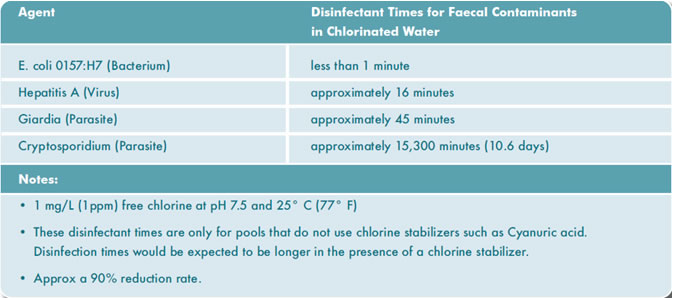On the edge: cryptosporidium can survive in a pool for up to ten days
The pool parasite we all want to control
Cryptosporidium represents a significant threat to pool users and pool operators alike. Robbie Phillips explains why this organism is so dangerous and how it can be managed to protect your swimmers and your business.
On the edge: cryptosporidium can survive in a pool for up to ten days
Cryptosporidium is a protozoan parasite that causes acute gastroenteritis, which can last up to two weeks but has been known to last even longer. Illness can also result in chronic, long-term infection.
Cryptosporidium inhabits the human gut, where it thrives and multiplies. Part of its life cycle involves the formation of dormant spores that act like a protective shell. These spores (known as cryptosporidium oocysts) are the mechanism for the transmission from one human host to another.
The oocysts are about five microns in diameter and are shed via stools in huge numbers (10⁶ to 10⁷per gram stool). Ingestion of fewer than 10 oocysts may be sufficient to cause infection. In addition, cryptosporidium oocysts are especially resistant to the chlorine and bromine disinfection in swimming pools, where they can survive for many days.
Patients can shed the cryptosporidium oocysts for up to two weeks after the symptoms have ceased. This is why it is crucial that people with diarrhoea must not swim and why people with cryptosporidiosis must not swim for two weeks after symptoms have ceased.
Cryptosporidiosis is a very unpleasant illness, whose main symptoms are watery diarrhoea, abdominal pain, fever and vomiting.
Cryptosporidiosis outbreaks are more frequently linked to learner/toddler pools than in main pools, which reflect the vulnerability of young children who could also be the source of infection. The oocysts sink only very, very slowly and because children often drink the water near the surface, the parasite has ready transmission to the intestine to cause infection and continue its life cycle. Similarly the introduction of interactive play features and young children defecating and drinking water from the sprays has presented other high risk factors.
The STA recommends that babies and children should not wear normal nappies in pools and similar facilities but a purpose-made costume with a purpose-made waterproof nappy. This aids the containment of solid stools and is referred to as the “double-nappy” system, where a second protective swim nappy layer is used over a disposable or reusable swim nappy.
However, even this double-nappy system does not fully contain loose, runny stools and specifically oocysts. Two thirds of cryptosporidiosis cases are among children, and mostly in the under-fives. With diarrhoea being more frequent within this age group and outbreaks more readily noticed, this group is the highest risk. Young children are also more susceptible to infection and a study by Dufour et al (2006) estimated that during a 45-minute swim a child would consume 37ml of water compared to an adult, who would ingest about 16ml. Very young children were not included in this study and the presumption would be that they consume more water, putting them at even more risk of infection.
Highly infectious
Cryptosporidium is highly infectious and research indicates that it can survive in a swimming pool for more than 10 days (see table below from the Centres of Disease Control & Prevention). Evidence also shows that cases of cryptosporidium peak in the spring and autumn, so it is essential that bathers and operators are educated about the risks that the organism poses.
Act now before it is too late
A swimming pool is often an underrated provision until things go wrong and they have to shut. It is therefore essential that leisure pool operators fully appreciate the consequences that a detected outbreak of cryptosporidium can have. These can include:
Best defence
We must keep cryptosporidium OUT of the pool to prevent outbreaks and the best defence is education, good hygiene and filtration. This can be summarised as follows:
These protocols also apply to any closed-circuit wet leisure provisions, such as conventional pools, hydro pools, paddling pools, interactive play features and fountains.
Robbie Phillips is the STA’s pool plant expert and is a regular contributor to the Leisure Review.
For further information contact the STA visit www.sta.co.uk
The Leisure Review, October 2014
© Copyright of all material on this site is retained by The Leisure Review or the individual contributors where stated. Contact The Leisure Review for details.
